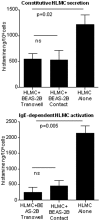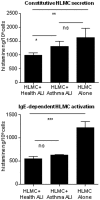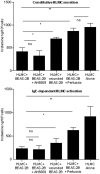Primary human airway epithelial cell-dependent inhibition of human lung mast cell degranulation
- PMID: 22970103
- PMCID: PMC3428358
- DOI: 10.1371/journal.pone.0043545
Primary human airway epithelial cell-dependent inhibition of human lung mast cell degranulation
Abstract
Introduction: Chronic mast cell activation is a characteristic feature of asthma. BEAS-2B human airway epithelial cells (AEC) profoundly inhibit both constitutive and IgE-dependent human lung mast cell (HLMC) histamine release. The aim of this study was to examine the regulation of HLMC degranulation by primary AEC from healthy and asthmatic subjects, and investigate further the inhibitory mechanism.
Methods: HLMC were co-cultured with both BEAS-2B and primary AEC grown as monolayers or air-liquid interface (ALI) cultures.
Results: Both constitutive and IgE-dependent HLMC histamine release were attenuated by BEAS-2B, primary AEC monolayers and ALI cultures. This occurred in the absence of HLMC-AEC contact indicating the presence of a soluble factor. Unlike healthy ALI AEC, asthmatic ALI-AEC did not significantly reduce constitutive histamine release. AEC inhibitory activity was transferable in primary AEC monolayer supernatant, but less active than with Transwell co-culture, suggesting that the inhibitory factor was labile. The AEC inhibitory effects were attenuated by both AEC wounding and pertussis toxin, indicating the involvement of a G(0)/G(i) receptor coupled mechanism. Solid phase extraction of lipids (<10 kDa) removed the AEC inhibitory activity. The lipid derivatives resolving D1 and D2 and lipoxin A(4) attenuated HLMC histamine release in a dose-dependent fashion but were not detectable in co-culture supernatants.
Conclusions: Primary AEC suppress HLMC constitutive and IgE-dependent histamine secretion through the release of a soluble, labile lipid mediator(s) that signals through the G(0)/G(i) receptor coupled mechanism. Manipulation of this interaction may have a significant therapeutic role in asthma.
Conflict of interest statement
Figures







Similar articles
-
Attenuation of human lung mast cell degranulation by bronchial epithelium.Allergy. 2006 May;61(5):569-75. doi: 10.1111/j.1398-9995.2006.01041.x. Allergy. 2006. PMID: 16629786
-
Engagement of the EP2 prostanoid receptor closes the K+ channel KCa3.1 in human lung mast cells and attenuates their migration.Eur J Immunol. 2008 Sep;38(9):2548-56. doi: 10.1002/eji.200738106. Eur J Immunol. 2008. PMID: 18792407 Free PMC article.
-
Bidirectional Counterregulation of Human Lung Mast Cell and Airway Smooth Muscle β2 Adrenoceptors.J Immunol. 2016 Jan 1;196(1):55-63. doi: 10.4049/jimmunol.1402232. Epub 2015 Nov 25. J Immunol. 2016. PMID: 26608913 Free PMC article.
-
Mechanisms of activation of human mast cells and basophils by general anesthetic drugs.Ann Fr Anesth Reanim. 1993;12(2):116-25. doi: 10.1016/s0750-7658(05)81020-2. Ann Fr Anesth Reanim. 1993. PMID: 7690200 Review.
-
Relationship between mediator release from human lung mast cells in vitro and in vivo.Int Arch Allergy Appl Immunol. 1985;77(1-2):47-56. doi: 10.1159/000233752. Int Arch Allergy Appl Immunol. 1985. PMID: 2409026 Review.
Cited by
-
Human airway mast cells proliferate and acquire distinct inflammation-driven phenotypes during type 2 inflammation.Sci Immunol. 2021 Feb 26;6(56):eabb7221. doi: 10.1126/sciimmunol.abb7221. Sci Immunol. 2021. PMID: 33637594 Free PMC article.
-
Modulation of Mast Cell Reactivity by Lipids: The Neglected Side of Allergic Diseases.Front Immunol. 2019 May 29;10:1174. doi: 10.3389/fimmu.2019.01174. eCollection 2019. Front Immunol. 2019. PMID: 31191542 Free PMC article. Review.
-
Culture conditions profoundly impact phenotype in BEAS-2B, a human pulmonary epithelial model.J Appl Toxicol. 2015 Aug;35(8):945-51. doi: 10.1002/jat.3094. Epub 2014 Dec 19. J Appl Toxicol. 2015. PMID: 25524072 Free PMC article.
-
Mast cells in airway diseases and interstitial lung disease.Eur J Pharmacol. 2016 May 5;778:125-38. doi: 10.1016/j.ejphar.2015.04.046. Epub 2015 May 8. Eur J Pharmacol. 2016. PMID: 25959386 Free PMC article. Review.
-
Insulin-induced lipid body accumulation is accompanied by lipid remodelling in model mast cells.Adipocyte. 2019 Dec;8(1):265-279. doi: 10.1080/21623945.2019.1636624. Adipocyte. 2019. PMID: 31311389 Free PMC article.
References
-
- Bradding P (2003) The role of the mast cell in asthma: a reassessment. Curr Opin Allergy Clin Immunol 3: 45–50. - PubMed
-
- Holgate ST (2010) A look at the pathogenesis of asthma: the need for a change in direction. Discov Med 9: 439–447. - PubMed
-
- Bradding P, Roberts JA, Britten KM, Montefort S, Djukanovic R, et al. (1994) Interleukin-4, -5, and -6 and tumor necrosis factor-alpha in normal and asthmatic airways: evidence for the human mast cell as a source of these cytokines. Am J Respir Cell Mol Biol 10: 471–480. - PubMed
-
- Bradding P, Walls AF, Holgate ST (2006) The role of the mast cell in the pathophysiology of asthma. J Allergy Clin Immunol 117: 1277–1284. - PubMed
Publication types
MeSH terms
Substances
Grants and funding
LinkOut - more resources
Full Text Sources

